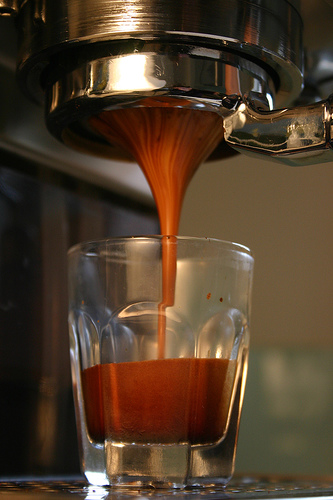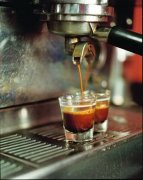A detailed account of the history of espresso espresso machines

History of espresso machines
The history of the commercial espresso machine in the usual coffee book will be unified as the piston-type pump machine invented by Gaggia in 1948. In the past 60 years, the big appearance and principle of the espresso machine have basically not changed greatly. It is a pity that the original exposed E61 type brewing port is no longer popular. Personally, I like that kind of very classical copper machine very much. However, fouling and copper rust are unavoidable problems. Modern medium-to-high-end machines, such as conti and La Marzocco, a special machine for starbucks, often use aluminum alloy boilers. Conti is a french machine that has also been used as a dedicated machine by coffee beanery. If you want to buy E61 machines, it seems that faema and other brands are still available, and even manual piston machines can be found, but the pressure cannot be guaranteed. Speaking of manual camera, it always reminds me that the earliest film camera was also hand-cranked. At that time, many photographers would shake very fast when they shot nervous shots. As a result, people on the screen moved crazy. Sometimes they would shake very slowly when they encountered calm and beautiful shots, so shaking film was a technical job at that time. It's the same now. If the pressure isn't enough, crema can't come out.
Gaggia is still producing espresso machines today, but all aspects of technology have fallen behind, and quality has declined, really let people feel that time flies ah.
espresso beans
We know that coffee beans are generally divided into Arabica and Robusta, the former is usually higher, the latter is promoted because the latter is easy to feed, just like weeds have strong vitality. The former is not only usually raised at high altitudes, but also susceptible to pests.
Robusta is usually the main ingredient in instant coffee, but it is sometimes added to espresso beans because it is easier to make crema, such as Lavazza's grand espresso, which is a blend of 60% Arabica and 40% Robusta.
Espresso beans are usually a blend of beans because it is a more balanced way of brewing coffee. Acidic espresso has been considered a problematic taste in the mouth of ordinary Shanghainese because of the toxicity of starbucks. Of course, slightly acidic espresso is not a popular taste, because there are too many uncontrolled factors, and the requirements for brista can be very high.
For each brand, espresso's bean blend formula is a trade secret, not as scary as protecting coca-cola's formula, but an important one. As far as we are familiar with illy or lavazza, in memory, the former is to choose 100% Arabica, while the latter has several different recipes. As mentioned earlier, Robusta is mainly used for cost control and easier to make Crema, but it will increase the caffeine content of espresso to a considerable extent, and it is not recommended for such formulations unless there is a special preference.
Many domestic bakers are producing beans with separate varieties. Generally speaking, Brazilian beans and Yemeni mocha beans are more suitable for single espresso use, but due to the purchase channel and baking level, especially for the selection of bad beans, domestic manufacturers are limited in providing espresso beans.
espresso temperature: 90.5 degrees Celsius
Forgetting who measured the temperature, it may be the result of a long trial, as if traditional Chinese medicine, ritual and experience all play a role in it. Below this temperature, the espresso becomes sour, and above that it becomes bitter. It wasn't just random. There was a time when my coffee machine was as cold as 80 degrees and the aftertaste of espresso became quite astringent. I thought it was the beans, but later I used the temperature gauge to find out what the problem was.
But 90.5 degrees is not a standard value, a senior brista will understand that factors such as air pressure will also affect coffee, high altitude areas will increase the temperature to match coffee beans, and French press coffee, the temperature is often as high as 95 degrees... So don't trust coffee drinkers who spread this temperature as a Bible.
Important Notice :
前街咖啡 FrontStreet Coffee has moved to new addredd:
FrontStreet Coffee Address: 315,Donghua East Road,GuangZhou
Tel:020 38364473
- Prev

General knowledge of boutique coffee how to distinguish the quality of ESPRESSO
ESPRESSO quality coffee, what is it? A drink, a carrier of taste, a way to feel the details of life. When you are in a cafe to enjoy a cup of coffee packaged by various cultures, have you ever thought about and learned to identify whether you are drinking a perfect cup of coffee, rather than spending dozens of yuan but washing pot water, so that you always feel
- Next

What is the basic knowledge of boutique coffee
Generally speaking, the benchmark of coffee in circulation in the market is based on the export specifications of each country.
Related
- Beginners will see the "Coffee pull flower" guide!
- What is the difference between ice blog purified milk and ordinary milk coffee?
- Why is the Philippines the largest producer of crops in Liberia?
- For coffee extraction, should the fine powder be retained?
- How does extracted espresso fill pressed powder? How much strength does it take to press the powder?
- How to make jasmine cold extract coffee? Is the jasmine + latte good?
- Will this little toy really make the coffee taste better? How does Lily Drip affect coffee extraction?
- Will the action of slapping the filter cup also affect coffee extraction?
- What's the difference between powder-to-water ratio and powder-to-liquid ratio?
- What is the Ethiopian local species? What does it have to do with Heirloom native species?

